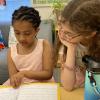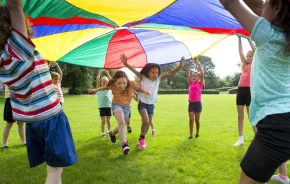
Before the pandemic, identifying gaps in schools wasn’t hard. Front-office staff handed out bandages, lamenting that nurses had to their split time between two schools. Food service workers knew kids were going hungry, unable to access free lunches due to missing paperwork. Principals wished for full-time counselors. Teachers bemoaned having to plan lessons centered around when they had access to the shared laptop cart. Students dreaded homework, knowing it would only get done if the Wi-Fi connection pirated from next door held up.
Before the pandemic, teachers could identify gaps in their own practice as well. They didn’t have the personal days to attend teaching conferences, the knowledge to make instructional videos or the energy to call multiple families after a busy day in the classroom.
All that changed in March 2020. Suddenly, schools found the money to get every student a laptop and a Wi-Fi hotspot. Breakfast, lunch and weekend food was available for anyone who needed or wanted it. Unable to be in the classroom, teachers hit the phones and found themselves having heartfelt conversations with parents they’d never connected with before. Conferences and teacher trainings flourished online.
Of course, this didn’t mean that everything was okay. The essential piece of education — people — fell away when schools closed. For all the gaps that had existed in schools, there had also been a lot of people piecing things together. Schools were full of teachers building relationships in their classrooms, deans facilitating social skills, counselors motivating reluctant learners, and specialists providing support for students with disabilities. Without all of this in-person support, failure rates skyrocketed and student engagement plummeted.
When full-day, in-person learning begins again this fall, not only will those personal connections return, but schools will also be ready to fill in the holes that have long existed in education. It’s going to be a good year.
ARP Act funding for much-needed staff
“Our district made the great choice of providing a full-time counselor to every single building!” Lyon Terry, assistant principal at Mount View Elementary School, joyfully announces when asked about the upcoming school year. After years of getting by with half-time counselors, the Highline school district is now able to use funds from the American Rescue Plan (ARP) Elementary and Secondary School Emergency Relief to hire more staff.
According to Washington state’s Office of Superintendent of Public Instruction, the relief funds are “to support students who … are likely to have suffered the most because of longstanding inequities in our communities and schools that have been exacerbated by the COVID-19 pandemic.”
This infusion of cash has allowed many schools to finally hire full-time nurses, psychologists and specialists. Districts are also using the money to continue providing laptops and Wi-Fi for every student — something teachers have spent the past decade begging for. When the pandemic hit, excuses about a lack of infrastructure or money woes fell away as districts realized they could provide technology to every student after all. Now, teachers are wondering if they can capitalize on that same sense of urgency to improve other aspects of education.
Technology driving changes in the classroom
Terry is enthusiastic about how students and teachers will bring their new technological skills into the classroom. “One of the things teachers loved about technology is the multiple ways kids could respond to assignments,” he says.
Students learned to share their learning by taking pictures of their work, asking questions in backchannel forums and making videos explaining what they’d learned. Teachers are planning to take these positive aspects from online learning and adapt them for the classroom. For example, the chat function in Zoom allowed shy students to share their thoughts nonverbally, and teachers want to continue the option for nonverbal engagement.
“All our teachers want whiteboard markers next year,” says Terry. Once back in the classroom, students will get their own mini whiteboards, so the whole class can respond to the teacher’s questions on their boards rather than by raising their hands. It’s hoped that this will mimic the chat function and encourage timid students to continue to share their thoughts.
“I was able to develop a YouTube personality, teaching to an online crowd,” jokes Peter Cheng, a math teacher at Juanita High School. “I had some fun with that. Just being creative with all the new online tools is something I’ll keep up after the pandemic is over.” After a year of learning how to efficiently create and share videos, Cheng imagines he’ll be able to use those skills to keep absent students up to speed, especially in AP calculus. If a student is sick or needs to miss school, Cheng has a trove of instructional videos to post so they won’t miss a beat.
Ten years ago, the concept of the “flipped classroom” took the ed-tech world by storm, suggesting that instead of having students learn at school and practice at home, they’d be better off learning new content at home (via instructional videos), so they could spend schooltime working, writing or solving practice problems. The model was appealing, but many teachers didn’t have the skills or time to create videos, and not all students had the technological capabilities to watch videos from home. Distance learning mitigated both of those concerns.
Virtual academies
Technological transformations are not only happening at the classroom level. Nearly all Seattle-area school districts have spent the spring and summer planning online schools for students who want to remain remote. While most students will be back in the classroom next year, many who thrived during online learning or need to remain at home due to health or family concerns will have that option.
Seattle Public Schools is piloting a 100 percent virtual option for a small number of K–12 students, prioritizing those with physical, mental and emotional health concerns. The Everett School District is offering a virtual academy for K–8 students, and Northshore will have a K–12 virtual program. In the Everett and Northshore models, students will spend 70 percent of their day virtually attending live teacher-led lessons, and the other 30 percent will be spent independently completing work.
The Highline Virtual Academy will follow a different model for students in grades 6–12 when it launches this fall, one focused on self-paced independent learning rather than live lessons. Principal Amy Carlson explains that it’s not “a plug-in model for kids, but … an instructional model that goes beyond that.” Teachers will build relationships with students through “advisory, one-on-one check-ins and small-group support. Our teachers will know our students by name, strengths and needs. … They’ll be creating a personalized learning instructional day for students.”
While a few districts have previously offered online options, the 2021–2022 school year will see nearly every school district make this an option. In the past, districts worried about online students being disconnected from their teachers, peers and school community, so family and student engagement remain top priorities.
A Note About Social Distancing and Safety MeasuresMany of the heightened safety measures from last winter and spring will fall away when school opens. Washington state schools will still require masks for students and teachers. However, temperature checks, daily screenings and attestation forms will no longer be required. Social distancing, which previously limited the number of students in the building, also will not be enforced. While the Washington State Department of Health recommends 3 feet of physical distancing in classrooms, “flexible language” in its guidance allows schools to permit a distance of less than 3 feet if needed to accommodate all students and staff, making the social distance requirements essentially meaningless. Read more about safety concerns and vaccine requirements here. |
Family connections and communication
In addition to gaining new technological skills, teachers doubled down on family engagement during distance learning.
“The biggest thing for me that I’ll try to keep up next year is contact with families,” says Cheng. “I had time to call parents, and for a lot of kids, that cooperation between the teacher and the parent was enough to push them through.”
Carlson experienced the same thing. “Never in my educational career did I witness the type of partnerships that happened with families and schools last year, and the absolute positive impact that had on our students,” she says. “I think schools and educators will be forever changed by that.”
Teachers relied on families to do some of the teaching, organizing and motivating that are typically done within the classroom environment, and they realized the power of strong family connections. At the same time, families were asked (often for the first time) what they needed from schools. Staff and teachers began to really listen and respond to community concerns with a new sense of urgency.
Putting students and families at the center
“We need to do what’s comfortable and accessible for our families, not what’s convenient for us,” says Brooke Brown, Washington state’s 2021 Teacher of the Year. “The pandemic really showed us that if it’s working for some students, that’s not good enough. We really need to focus on every student’s learning and connecting with every family.”
After 15 years of teaching at Washington High School in Parkland, Brown has taken a new position with the Franklin Pierce School District as an instructional equity specialist. She’ll focus on implementing restorative justice practices and bringing ethnic studies into classrooms from preschool through 12th grade.
While Brown has long believed that schools need to put students and families at the center of everything, she’s excited to use new tools to make this happen: She hopes Zoom will continue to give families options for attending meetings and conferences, and that new online learning platforms will afford students more choices and more ways to demonstrate their learning. Brown has been creating her own new tools as well.
“Last summer after George Floyd was murdered, some friends and I put together this idea that we had to help with teacher development and classroom environment — really having an anti-racist, trauma-informed lens.” she explains. “Teachers take a survey and place themselves on a spectrum from exclusive to fully transformed. …They survey their students and, based on their own analysis and their students’ feedback, they create a goal and present it to their students and families.”
So often, students (and by extension, their parents and guardians) are subject to teacher demands and expectations. Brown’s tool flips accountability by asking students what they need. Students get to hold their teachers accountable, too. Brown’s whirlwind of plans for next year also include bringing yoga and mindfulness into schools, starting each day with social justice quotes and training students as restorative justice mentors. “If anything is remotely the same from when we left, then we aren’t imagining enough and we need to do more work,” she says.
After a year of reflection, learning, transforming curricula and deeply missing their students, teachers everywhere are excited and ready for post-pandemic education. It’s going to be a good school year.
Test Scores No Longer Required for UW AdmissionCollege applicants will no longer be required to submit SAT or ACT test scores to the University of Washington. “It’s a permanent change,” says Paul Seegert, director of admissions at UW. “Last year, it was done specifically for COVID. However, we had already been seriously considering removing the requirement.” Test scores had increasing become less predictive of success at UW, and for years, admission officials hadn’t been putting much stock in them. “Even though we knew that test scores rarely made a difference in the outcome of a student’s application, there was so much stress and anxiety that it was outsized compared to the value of test scores,” says Seegert. Therefore, the UW admissions office decided to simply remove the barrier and no longer require test scores. High school students should focus on their grades and course load instead of test prep. |











